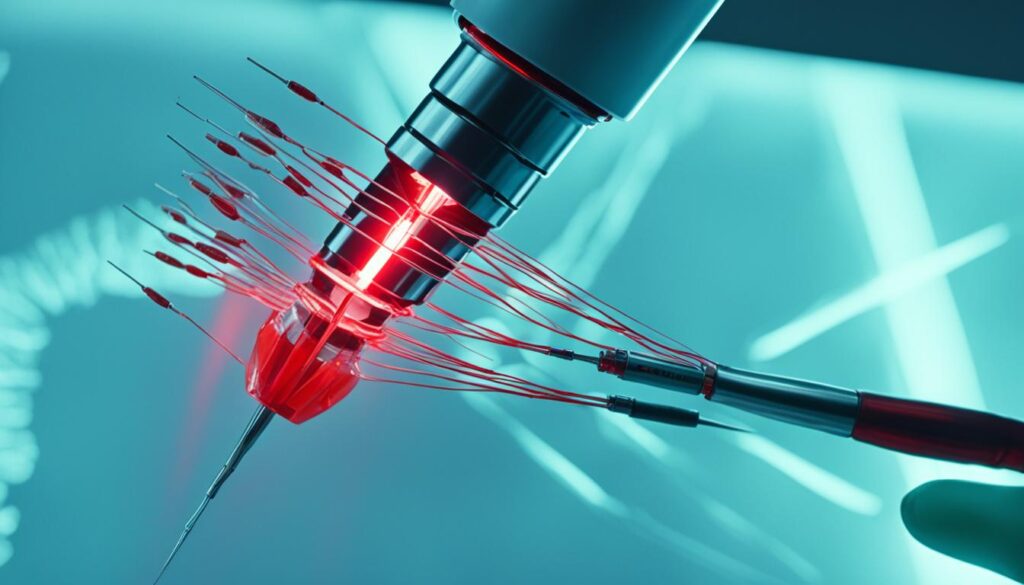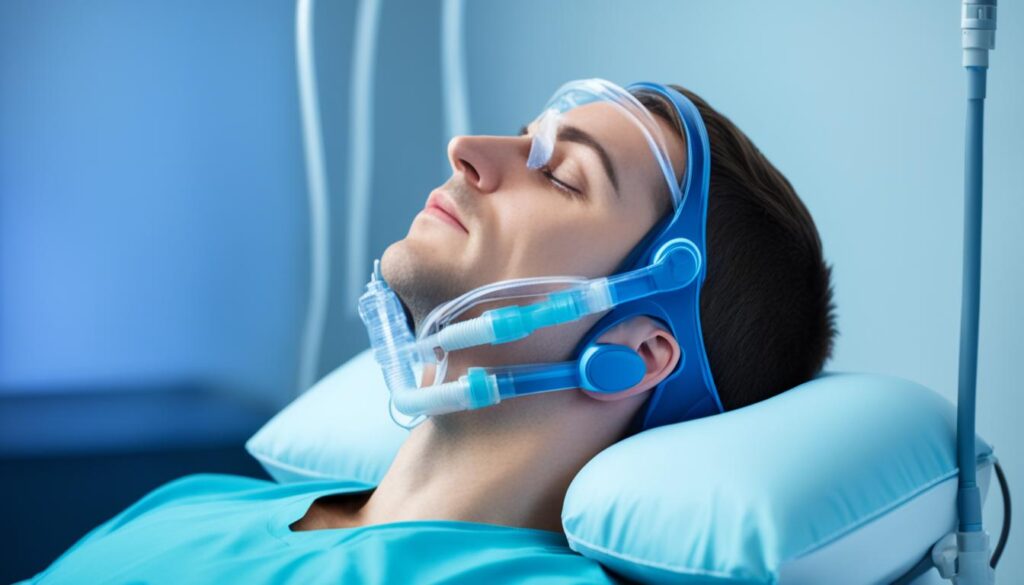Cluster headaches can bring about intense pain and disrupt your daily life. If you’re seeking relief from this debilitating condition, there are effective treatment options available to help manage and reduce the frequency of cluster headache attacks.
Diagnosing cluster headaches requires a careful assessment by a neurologist for cluster headache treatment who evaluates your symptoms, medical history, and performs a physical exam. Advanced imaging like MRI or CT scans may be recommended to exclude other potential causes. Trusted centers like the Mayo Clinic offer comprehensive care backed by neurological expertise.
Key Takeaways:
- Cluster headaches can be effectively managed with the right treatment approach.
- A neurologist plays a key role in diagnosing cluster headaches through careful evaluation.
- Imaging tests may be used to rule out other causes of the pain.
- Cluster headache treatment options can help reduce pain and prevent future episodes.
Table of Contents
ToggleFast-Acting Treatments
When you experience a cluster headache, fast-acting treatments can provide the relief you need to manage the intense pain and reduce the duration of attacks. These treatments are designed to stop a cluster headache once it has started, offering you immediate relief and comfort. Here are some effective and fast-acting cluster headache treatments:
Oxygen Therapy
One of the most widely used fast-acting treatments for cluster headaches is oxygen therapy. Breathing in pure oxygen through a mask can provide significant relief within just 15 minutes for most individuals. This treatment helps alleviate the pain and discomfort associated with cluster headaches, allowing you to get back to your daily activities.
Triptans
Triptans, such as sumatriptan, are another effective option for fast relief from cluster headaches. Sumatriptan can be administered as a shot or nasal spray, delivering quick results. This medication works by targeting the underlying causes of the headache, providing relief from the intense pain and other symptoms associated with cluster headaches.
Other Options
In addition to oxygen therapy and triptans, there are other fast-acting treatments available for cluster headaches. These include:
- Octreotide
- Local anesthetics
- Dihydroergotamine
While these options may not be as commonly used as oxygen therapy and triptans, they can still be effective in providing relief from the pain and discomfort of cluster headaches.
| Treatment | Administration Method | Time to Relief |
|---|---|---|
| Oxygen Therapy | Through a mask | Within 15 minutes |
| Triptans (e.g., sumatriptan) | Shot or nasal spray | Varies (usually within an hour) |
| Octreotide | Injection | Varies (usually within an hour) |
| Local Anesthetics | Injection | Varies (usually within an hour) |
| Dihydroergotamine | Injection or nasal spray | Varies (usually within an hour) |
As with any treatment, it’s important to consult with your healthcare provider to determine the most appropriate fast-acting treatment option for your specific needs and medical history.

Preventive Treatments
Preventive therapy plays a crucial role in managing cluster headaches and reducing their frequency. By proactively addressing the underlying causes, these treatments aim to prevent cluster headaches from occurring altogether. Several effective preventive treatments are available to provide relief and improve your quality of life.
1. Verapamil
One of the primary medications used for preventing cluster headaches is verapamil, a calcium channel blocker. Verapamil is often the first choice due to its effectiveness in reducing the frequency and severity of cluster headaches. It is typically prescribed in daily doses and may be combined with other preventive medications to enhance the overall effectiveness.
2. Corticosteroids
In some cases, corticosteroids are used as a short-term treatment to provide fast relief until long-term preventive medicines start to take effect. These powerful anti-inflammatory medications can quickly reduce the intensity of cluster headache attacks. However, due to their potential side effects, corticosteroids are generally used for short periods.
3. Galcanezumab
Galcanezumab is a relatively new preventive treatment option for cluster headaches. It is a monoclonal antibody that specifically targets calcitonin gene-related peptide (CGRP), a molecule involved in the development of cluster headache attacks. Administered as a monthly injection, galcanezumab has shown promising results in reducing the frequency of cluster headaches.
4. Lithium
Lithium, a mood stabilizer commonly used in the treatment of bipolar disorder, has also been found to have preventive effects on cluster headaches. This medication helps regulate neurotransmitter activity in the brain, potentially reducing the occurrence of cluster headache episodes. However, regular monitoring of lithium levels is necessary to ensure its safety and effectiveness.
5. Noninvasive Vagus Nerve Stimulation
Noninvasive vagus nerve stimulation (nVNS) is a non-drug preventive treatment option that targets the vagus nerve, which plays a key role in regulating pain signals in the brain. nVNS involves using a handheld device to deliver mild electrical impulses to the vagus nerve through the skin on the neck. This therapy has been shown to reduce the frequency and intensity of cluster headaches in some individuals.
Preventive treatments for cluster headaches can be highly effective in managing the condition and improving your overall quality of life. It is important to work closely with a healthcare professional who specializes in headache management to determine the most suitable preventive treatment plan for your specific needs and circumstances.

Surgery for Cluster Headaches
Surgery is rarely used as a treatment option for cluster headaches. It is typically reserved for individuals who do not respond to other treatments such as medications or lifestyle changes. Surgical procedures for cluster headaches aim to damage the nerve pathways believed to cause the pain. However, the long-term benefits of these surgeries are uncertain, and complications can arise.
Several potential surgical options for cluster headaches are being studied. These include:
- Sphenopalatine ganglion stimulation: This procedure involves placing a small device near the nerves responsible for cluster headache pain. The device delivers electrical impulses to disrupt the pain signals.
- Occipital nerve stimulation: In this surgery, electrodes are implanted near the occipital nerves at the back of the head. The electrodes send electrical impulses to the nerves to alleviate cluster headache symptoms.
- Deep brain stimulation: This surgical procedure involves implanting electrodes in the brain to deliver electrical impulses. It is typically used for other neurological conditions but is being explored as a potential option for cluster headaches.
It’s important to note that these surgeries are still under investigation and may not be widely available or approved for cluster headache treatment.

Comparison of Surgical Options for Cluster Headaches
| Procedure | Description | Potential Benefits | Potential Risks/Complications |
|---|---|---|---|
| Sphenopalatine ganglion stimulation | Placement of a device near the nerves responsible for cluster headache pain to disrupt pain signals. | – Pain relief – Decreased frequency and intensity of cluster headaches | – Infection at the implant site – Device malfunction – Bleeding – Facial pain or numbness – Changes in taste or smell |
| Occipital nerve stimulation | Implantation of electrodes near the occipital nerves to alleviate cluster headache symptoms. | – Reduction in cluster headache pain | – Infection at the implant site – Device-related complications – Wound healing issues – Numbness or tingling in the scalp – Possible need for additional surgeries |
| Deep brain stimulation | Implantation of electrodes in the brain to deliver electrical impulses. | – Potential reduction in cluster headache frequency | – Risk of bleeding or infection during surgery – Device-related complications – Changes in mood, behavior, or cognitive function – Possible need for additional surgeries |
Lifestyle Changes and Home Remedies
When it comes to managing cluster headaches, certain lifestyle changes can make a significant difference. By incorporating these changes into your daily routine, you may be able to reduce the frequency and severity of your headaches. Additionally, there are some home remedies that you can try to alleviate the pain and discomfort associated with cluster headaches.
Maintaining a Regular Sleep Schedule
A regular sleep schedule is essential for managing cluster headaches. Lack of sleep or irregular sleep patterns can trigger headache episodes. It is recommended to establish a consistent sleep routine by going to bed and waking up at the same time every day, even on weekends. Creating a relaxing bedtime routine and optimizing your sleep environment with comfortable bedding and minimal distractions can also help improve the quality of your sleep.
Avoiding Alcohol
Alcohol consumption is a known trigger for cluster headaches. If you are prone to cluster headaches, it is advisable to avoid or limit your intake of alcoholic beverages. Alcohol can dilate blood vessels and increase the likelihood of a headache episode. It’s important to be mindful of your alcohol consumption and identify any patterns between alcohol intake and your headache attacks.
Alternative Treatments
In addition to lifestyle changes, there are alternative treatments that may provide relief for some individuals. It’s important to consult with a healthcare provider before trying these options to ensure they are safe and appropriate for your specific situation. Two alternative treatments that have shown promise in managing cluster headaches are:
- Melatonin: Melatonin is a hormone that regulates sleep-wake cycles. Some research suggests that taking melatonin supplements may help prevent cluster headaches and improve sleep quality. However, more studies are needed to confirm its effectiveness.
- Capsaicin Nasal Spray: Capsaicin, an active component of chili peppers, has been used in nasal sprays to relieve cluster headache pain. It works by desensitizing the nerve fibers in the nasal passages. However, the use of capsaicin nasal spray should be done under medical supervision due to potential side effects and individual sensitivity.
Seeking Support
Coping with cluster headaches can be challenging, both physically and emotionally. It’s important to remember that you are not alone in your journey. Seeking support from a counselor or joining a headache support group can provide a sense of belonging, understanding, and valuable coping strategies. Connecting with others who share similar experiences can help you navigate the challenges of living with cluster headaches.
| Benefit of Seeking Support | How to Access Support |
|---|---|
| Emotional support | Join a local or online headache support group |
| Information and resources | Consult with a headache specialist or counselor |
| Coping strategies | Attend counseling sessions or therapy focused on pain management |
Preparing for Your Appointment
If you suspect you have cluster headaches, it’s important to prepare for your appointment with a primary care provider or neurologist. By taking a proactive approach, you can ensure that your concerns are properly addressed and increase the likelihood of an accurate diagnosis and effective treatment plan.
1. Keep a Headache Diary
One of the most valuable tools you can bring to your appointment is a headache diary. This diary should include detailed information about your headaches, including the date, duration, intensity, triggers, symptoms, and any relief measures you have tried. Documenting this information will help your healthcare provider better understand your condition and make informed decisions about your diagnosis and treatment.
2. Bring a Supportive Companion
Consider asking a family member or friend to accompany you to your appointment. Having a supportive companion can be helpful in several ways. They can offer emotional support during a potentially stressful appointment and help you remember important information that may be discussed. Additionally, they can provide another perspective and help ask questions that you may not have thought of.
3. Prepare a List of Questions
Prior to your appointment, take the time to write down any questions or concerns you have about your symptoms, diagnosis, and treatment options. This will ensure that you cover all important topics during your appointment and help you make informed decisions about your healthcare. Some questions you may consider asking include:
- What tests are needed to confirm a diagnosis of cluster headaches?
- What are the possible triggers for my cluster headaches?
- What treatment options are available for cluster headaches?
- Are there any lifestyle changes I can make to help manage my cluster headaches?
- What are the potential side effects of the recommended treatments?
- Are there any alternative therapies or complementary treatments that may be beneficial?
By preparing a list of questions in advance, you can make the most of your time with your healthcare provider and ensure that all of your concerns are addressed.
Remember, effective communication with your healthcare provider is key to receiving the best possible care for your cluster headaches. By following these tips, you can be well-prepared for your appointment and take an active role in your diagnosis and treatment process.
| Key Points for Preparing for Your Appointment: |
|---|
| Keep a headache diary to provide valuable information about your symptoms. |
| Bring a supportive companion to help remember important information. |
| Prepare a list of questions to ask your healthcare provider. |

Diagnosis and Treatment Studies
Research plays a crucial role in understanding and improving the diagnosis and treatment of cluster headaches. Several studies have been conducted to evaluate the effectiveness of different medications and therapies in managing this condition.
Diagnostic Studies
A variety of diagnostic studies have been conducted to aid in the accurate identification and classification of cluster headaches. These studies help healthcare providers formulate an appropriate treatment plan based on a patient’s specific symptoms and medical history.
Treatment Studies
Research on cluster headache treatments aims to find effective approaches to reduce the frequency, intensity, and duration of cluster headache attacks. Various medications and therapies have been evaluated to determine their efficacy in managing this condition.
| Medication/Therapy | Effectiveness |
|---|---|
| Oxygen Therapy | Studies have shown that breathing in pure oxygen during an attack can provide significant relief and shorten the duration of cluster headaches. |
| Triptans | Triptans, such as sumatriptan, have been found to effectively alleviate cluster headache symptoms and shorten the duration of attacks. |
| Dihydroergotamine | Research suggests that dihydroergotamine can be an effective alternative for individuals who do not respond well to other medications. |
| Verapamil | Verapamil, a calcium channel blocker, is commonly used as a preventive treatment for cluster headaches and has shown positive results. |
| Corticosteroids | Short-term use of corticosteroids, such as prednisone, has demonstrated rapid relief for individuals experiencing acute cluster headache attacks. |
| Noninvasive Vagus Nerve Stimulation | Research suggests that noninvasive vagus nerve stimulation can help reduce the frequency and severity of cluster headaches. |
These studies not only contribute to the advancement of cluster headache treatments but also help healthcare providers make well-informed decisions when developing individualized treatment plans.
Incidence and Prevalence of Cluster Headaches
Cluster headaches are relatively rare, affecting a small percentage of the general population. The incidence and prevalence of cluster headaches vary across different populations and regions. Understanding the frequency and occurrence of cluster headaches is crucial for healthcare providers to develop effective treatment strategies.
Estimates suggest that cluster headaches have a prevalence of approximately 0.1% in the general population. This means that out of every 1,000 individuals, about 1 would experience cluster headaches. While the overall prevalence may be low, it is important to note that cluster headaches significantly impact the lives of those affected.
Cluster headaches are more commonly observed in men than in women. The male-to-female ratio of cluster headache patients is approximately 3:1. However, research has shown that women can also experience cluster headaches, particularly during certain phases of their reproductive life cycle.
The age of onset for cluster headaches typically falls between 20 and 40 years old. However, cluster headaches can occur at any age, with cases reported in adolescents and older adults. The exact reasons for the age distribution of cluster headaches are not yet fully understood and require further investigation.
Incidence and Prevalence Across Populations
Studies have revealed variations in the incidence and prevalence of cluster headaches across different populations and geographical regions. These disparities suggest that genetic, environmental, and cultural factors may contribute to the development of cluster headaches.
For example, a study conducted in India reported a higher prevalence of cluster headaches compared to Western countries. The study found a prevalence rate of 0.5% in the Indian population, indicating a higher burden of cluster headaches in this region.
To gain a comprehensive understanding of cluster headaches, further research is needed to explore the specific factors influencing the incidence and prevalence of cluster headaches in different populations. By unraveling these complexities, healthcare professionals can provide more targeted and effective treatments tailored to the needs of diverse patient groups.
Oxygen Therapy for Cluster Headaches
Oxygen therapy is a widely used treatment for cluster headaches, providing fast and effective relief. Breathing in pure oxygen through a mask can significantly reduce the pain and duration of cluster headache attacks. Numerous studies have shown the benefits of high-flow oxygen in managing these debilitating headaches.
The mechanism behind oxygen therapy for cluster headaches is not fully understood, but it is believed that inhaling high levels of oxygen helps constrict the blood vessels in the brain, relieving the intense pain associated with cluster headaches.

Oxygen Therapy vs. Medication
Oxygen therapy is a non-invasive treatment option that is generally safe and does not cause significant side effects. It can be used alone or in combination with other acute treatments for cluster headaches. Compared to medications such as triptans, oxygen therapy has been shown to provide faster relief and has fewer potential side effects.
How to Perform Oxygen Therapy for Cluster Headaches
Oxygen therapy for cluster headaches involves using a face mask or a nasal cannula to deliver high-flow oxygen. The typical flow rate is 12-15 liters per minute, and the duration of each session is usually 15-20 minutes.
A portable oxygen concentrator can be used to administer oxygen therapy, allowing individuals to receive treatment at home or while on the go. It is important to follow your healthcare provider’s instructions regarding the use of oxygen therapy and to ensure that you have access to a reliable supply of oxygen.
Effectiveness of Oxygen Therapy for Cluster Headaches
The effectiveness of oxygen therapy for cluster headaches is well-documented. Studies have consistently shown that high-flow oxygen can provide rapid relief from pain and abort cluster headache attacks. According to the American Headache Society, oxygen therapy is considered a first-line treatment for acute cluster headaches and is recommended as a primary option for individuals who prefer non-pharmacological approaches or cannot tolerate medications.
Considerations and Precautions
Oxygen therapy is generally safe, but there are some considerations to keep in mind:
- Consultation with a healthcare provider is essential to determine if oxygen therapy is appropriate for you.
- Oxygen therapy may not be suitable for individuals with severe chronic obstructive pulmonary disease (COPD) or other respiratory conditions.
- Pure oxygen is not flammable, but it supports combustion. Therefore, it is important to take precautions and avoid open flames or smoking during oxygen therapy.
If you experience cluster headaches and are looking for an effective and non-pharmacological treatment option, oxygen therapy may be a suitable choice for you. Consult with a healthcare professional to discuss whether oxygen therapy is right for your specific situation.
| Advantages | Disadvantages |
|---|---|
|
|
Triptans for Acute Treatment of Cluster Headaches
Triptans, such as sumatriptan, are commonly used for the acute treatment of cluster headaches. Sumatriptan can be administered as a shot, nasal spray, or oral tablet to provide relief from cluster headache symptoms. The nasal spray and injection forms of sumatriptan work faster compared to the oral form, allowing for more rapid relief.
When taken during a cluster headache attack, triptans work by constricting the blood vessels in the brain and reducing inflammation, which helps alleviate the intense pain. These medications can also target other symptoms commonly associated with cluster headaches, such as nausea and sensitivity to light and sound.
Sumatriptan has been extensively studied and has shown significant efficacy as an acute treatment option for cluster headaches. Another triptan, zolmitriptan, has also demonstrated effectiveness in relieving cluster headache symptoms.
Sumatriptan Administration Modes:
Sumatriptan offers different modes of administration to cater to individual preferences and needs:
- Oral tablet: This is the most commonly used form of sumatriptan. It is taken by mouth with water and absorbed into the bloodstream.
- Nasal spray: Sumatriptan nasal spray is administered by inserting the nozzle into the nostril and spraying the medication. The nasal mucosa absorbs the medication, allowing for quick absorption into the bloodstream.
- Injection: Sumatriptan can also be administered as a subcutaneous injection. This mode offers fast-acting relief as the medication is directly delivered into the body’s system.
It’s important to note that the choice of administration mode depends on factors such as individual preferences, the intensity of the headache, and the speed of relief desired. Your healthcare provider can guide you in selecting the most suitable option for your cluster headache treatment.
| Treatment Method | Efficacy | Administration |
|---|---|---|
| Sumatriptan | Effective | Oral tablet, nasal spray, injection |
| Zolmitriptan | Effective | Oral tablet, nasal spray |
In conclusion, triptans, such as sumatriptan, offer an effective acute treatment option for cluster headaches. With various modes of administration available, these medications provide relief by targeting the underlying mechanisms of cluster headaches. Consulting with a healthcare provider can help determine the most suitable triptan and administration mode for managing cluster headache symptoms.
Steroids for Cluster Headache Treatment
Steroids, particularly corticosteroids, can provide rapid relief for cluster headaches. They are a type of medication that mimics the effects of hormones produced by the adrenal glands. When used in the treatment of cluster headaches, corticosteroids can help reduce the severity and duration of attacks.
Corticosteroids work by reducing inflammation in the body, including in the blood vessels and nerves that are involved in cluster headaches. They can be effective in managing cluster headaches, especially during the initial phase of treatment when preventive medications have not fully taken effect. Doctors may prescribe corticosteroids to alleviate symptoms and provide temporary relief.
However, it’s important to note that corticosteroids are typically used for short periods, as long-term use can lead to serious side effects. These side effects may include:
- Increased blood sugar levels, which can potentially lead to diabetes
- High blood pressure
- Osteoporosis, a condition characterized by weakened and brittle bones
Your healthcare provider will carefully evaluate the potential risks and benefits of corticosteroid treatment for your individual situation. They will consider factors such as the frequency and severity of your cluster headaches and your overall health. Corticosteroids may be used as a short-term solution to alleviate symptoms until other preventive medications start working.
It’s essential to follow your healthcare provider’s instructions when using corticosteroids for cluster headaches. Abruptly stopping the medication or changing the dosage without medical supervision can have adverse effects. Your healthcare provider will monitor your progress and adjust your treatment plan as necessary to ensure the best outcome for your cluster headache management.
Risks and Side Effects of Corticosteroids
While corticosteroids can provide temporary relief for cluster headaches, they are not without risks and side effects. It’s crucial to be aware of the potential risks associated with their use. Some possible side effects of corticosteroids include:
- Weight gain
- Mood changes, such as irritability or anxiety
- Sleep disturbances
- Increased appetite
- Fluid retention
- Suppressed immune system function
If you experience any concerning side effects or have any questions or concerns about corticosteroid treatment for cluster headaches, be sure to discuss them with your healthcare provider. They are the best resource to provide you with the necessary guidance and support in managing your condition effectively.
Next, let’s explore an informative table that compares the different treatments for cluster headaches, including corticosteroids. This table will help you understand the various options available and their potential benefits and side effects.
Treatments for Cluster Headaches: A Comparison
| Treatment | Benefits | Side Effects |
|---|---|---|
| Steroids (Corticosteroids) | Rapid relief | – Increased blood sugar levels – High blood pressure – Osteoporosis |
| Oxygen Therapy | Fast-acting relief Non-invasive | – Nasal dryness – Claustrophobia (if using a mask) |
| Triptans | Effective for acute attacks Multiple delivery methods | – Nasal irritation (nasal spray) – Injection site reactions (injections) |
| Preventive Medications | Reduces frequency and intensity | – Fatigue – Nausea – Dizziness – Dry mouth |
As illustrated in the table above, corticosteroids offer rapid relief for cluster headaches, but they come with the risk of side effects such as increased blood sugar levels, high blood pressure, and osteoporosis. It’s important to consult with your healthcare provider to determine the most suitable treatment plan for your specific condition and needs.
Now that we have explored the use of steroids for cluster headache treatment, let’s move on to the next section, which focuses on lifestyle changes and home remedies that can complement medical treatments for cluster headaches.
Conclusion
Cluster headaches can be extremely debilitating, causing intense pain and disrupting daily life. However, there are effective treatment options available to manage and alleviate the symptoms of cluster headaches.
For fast relief during acute attacks, options such as oxygen therapy and triptans, like sumatriptan, can provide significant relief. These treatments work quickly and effectively to alleviate pain and shorten the duration of cluster headache episodes.
In addition to fast-acting treatments, preventive medications are available to help reduce the frequency and severity of cluster headaches. Medications like verapamil and corticosteroids can be used to prevent cluster headaches from occurring. Lifestyle changes, such as maintaining a regular sleep schedule and avoiding triggers like alcohol, can also play a role in managing cluster headaches.
In more severe cases or when other treatments are ineffective, surgical options may be considered. However, surgery is typically a last resort and is only recommended in specific situations. It’s crucial to work closely with a healthcare provider to determine the best treatment approach for your individual needs, as each person’s experience with cluster headaches can vary.
FAQ
What are cluster headaches?
Cluster headaches are a specific type of headache characterized by intense pain and a distinct pattern of attacks.
How are cluster headaches diagnosed?
Diagnosis is typically made by a neurologist based on symptoms, medical history, and physical examination. Diagnostic tests such as MRI and CT scans may be used to rule out other causes of the pain.
What are the goals of cluster headache treatment?
The goals of treatment for cluster headaches are to reduce pain, shorten the duration of attacks, and prevent future episodes.
What are the fast-acting treatments for cluster headaches?
Fast-acting treatments for cluster headaches include breathing in pure oxygen through a mask and using medications such as triptans or local anesthetics.
What are the preventive treatments for cluster headaches?
Preventive treatments for cluster headaches include medications like verapamil and corticosteroids, as well as noninvasive vagus nerve stimulation.
Is surgery an option for cluster headache treatment?
Surgery is rarely used for the treatment of cluster headaches and is typically reserved for individuals who do not respond to other treatments.
What lifestyle changes can help manage cluster headaches?
Maintaining a regular sleep schedule and avoiding triggers like alcohol can help manage cluster headaches. Alternative treatments like melatonin and capsaicin nasal spray may also provide relief for some individuals.
How can I prepare for my cluster headache appointment?
Keeping a headache diary, bringing a family member or friend to the appointment, and preparing a list of questions for your doctor are all helpful when preparing for a cluster headache appointment.
What research has been done on cluster headache diagnosis and treatment?
Several studies have been conducted to evaluate the diagnosis and treatment of cluster headaches, focusing on the effectiveness of various medications and preventive treatments.
How common are cluster headaches?
Cluster headaches are relatively rare, with an estimated prevalence of 0.1% in the general population. They affect more men than women, and the age of onset is typically between 20 and 40 years old.
How effective is oxygen therapy for cluster headaches?
Oxygen therapy is a widely used treatment for cluster headaches, providing relief within a short period of time for most individuals.
What are triptans and how are they used to treat cluster headaches?
Triptans, such as sumatriptan, are commonly used for the acute treatment of cluster headaches. They can be given as shots, nasal sprays, or oral tablets and are effective in stopping cluster headache symptoms.
How do steroids help in the treatment of cluster headaches?
Steroids, particularly corticosteroids, can provide rapid relief for cluster headaches, especially when preventive medications have not fully taken effect. However, long-term use of steroids can have serious side effects.
What are the available treatment options for cluster headaches?
There are various treatment options available for cluster headaches, including fast-acting treatments, preventive medications, lifestyle changes, and surgical options. The best approach depends on individual needs and should be determined in consultation with a healthcare provider.
Source Links
About The Author

This article is medically reviewed by Dr. Chandril Chugh, Board-Certified Neurologist, providing expert insights and reliable health information.
Dr. Chandril Chugh is a U.S.-trained neurologist with over a decade of experience. Known for his compassionate care, he specializes in treating neurological conditions such as migraines, epilepsy, and Parkinson’s disease. Dr. Chugh is highly regarded for his patient-centered approach and dedication to providing personalized care.
→ Book a consultation to discover which remedies suit your needs best.




